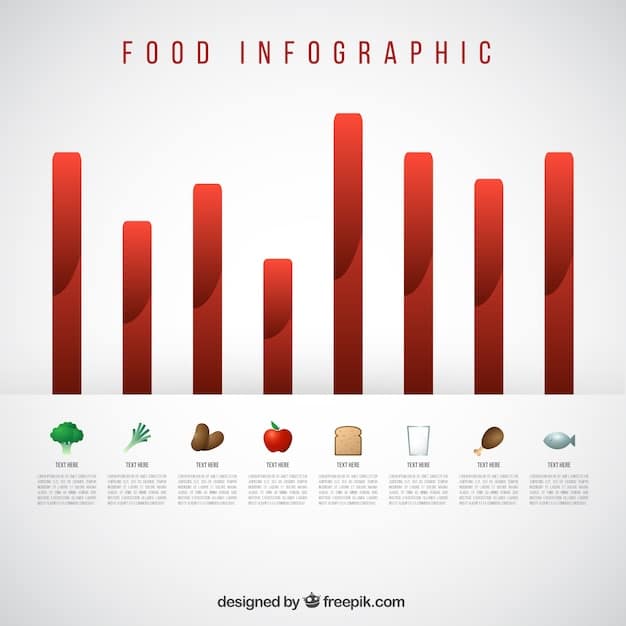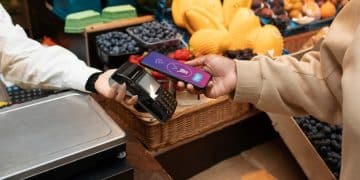The Ultimate Guide to Grocery Savings in 2025: Coupons & Rebates

Navigating the complexities of grocery shopping can be daunting, but a strategic approach to employing coupons and rebates offers a powerful avenue for substantial savings, enabling consumers to effectively manage household budgets in 2025 without compromising on quality or essentials.
In today’s dynamic economic landscape, every dollar counts, especially when it comes to essential expenditures like groceries. For savvy shoppers, mastering the art of utilizing coupons and rebates isn’t just a smart move, it’s a necessity. This comprehensive guide, The Ultimate Guide to Using Coupons and Rebates for Maximum Grocery Savings in 2025, aims to equip you with the knowledge and strategies to significantly reduce your grocery bill, ensuring you get the most value for your money.
Understanding the Landscape of Grocery Savings in 2025
The world of grocery savings is constantly evolving, driven by technological advancements and shifting consumer behaviors. In 2025, understanding these changes is crucial for maximizing your savings potential. From traditional paper coupons to sophisticated digital rebate programs, the opportunities are more diverse than ever before. This introductory section sets the stage, providing an overview of what to expect and how to prepare for a successful savings journey.
The shift towards digital platforms has been monumental, transforming how we access and redeem discounts. No longer are we solely reliant on newspaper inserts; smartphones and retailer apps have become indispensable tools. This evolution demands a new set of skills and a proactive approach to discover the best deals available.
The Digital Coupon Revolution
Digital coupons have surged in popularity, offering unparalleled convenience and accessibility. These are often loaded directly onto loyalty cards or redeemed via QR codes at checkout, streamlining the savings process. Retailers are increasingly favoring digital platforms due to their tracking capabilities and ability to offer personalized promotions.
- Instant Access: Digital coupons are available 24/7 through apps and websites.
- Personalized Offers: Retailers tailor deals based on past purchases and preferences.
- Eco-Friendly: Reduces paper waste associated with traditional coupon clipping.
Beyond convenience, digital coupons frequently offer higher value discounts on specific brands or categories, incentivizing repeat purchases and brand loyalty. Understanding how to effectively navigate these platforms is your first step towards unlocking significant savings.
The Resurgence of Rebates
Rebates, once cumbersome and time-consuming, have experienced a modern revival, largely thanks to mobile applications. These apps simplify the submission process, allowing shoppers to claim cash back or gift cards by simply scanning receipts or product barcodes. Whereas coupons provide instant savings at the register, rebates offer post-purchase reimbursement, often allowing for “stacking” of savings.
The beauty of modern rebates lies in their simplicity and the potential to combine them with other discounts. Imagine using a coupon at checkout and then submitting your receipt for a rebate on the same item, effectively doubling your savings. This strategy, often overlooked, can lead to substantial reductions in your overall grocery expenditure.
In conclusion, 2025 offers a rich tapestry of savings opportunities for grocery shoppers. By embracing both the digital frontier of coupons and the simplified process of modern rebates, consumers can strategically reduce their expenses and enhance their financial well-being. The key is to stay informed, proactive, and willing to adapt to new and evolving saving methodologies.
Strategic Couponing: Finding, Organizing, and Redeeming Smartly
The art of couponing goes beyond simply clipping discounts; it involves a strategic approach to finding the right coupons, organizing them efficiently, and redeeming them at the optimal time. For maximum grocery savings in 2025, a well-thought-out plan is essential to transform sporadic discounts into consistent, substantial reductions on your grocery bill.
Effective couponing requires diligence and a methodical mind. It’s about knowing where to look, how to sort, and when to act. The goal is to make couponing a seamless part of your grocery routine, not an overwhelming chore.
Where to Find the Best Coupons
The sources for coupons have diversified significantly. While the Sunday newspaper inserts (“SmartSource” and “Save” are common brands) remain a foundational source for many, digital avenues now offer an abundance of opportunities. Retailer websites and apps are increasingly providing exclusive, high-value coupons directly to their loyalty program members.
- Newspaper Inserts: Still a reliable source for physical coupons, especially for brand-name products.
- Printable Coupon Websites: Sites like Coupons.com and P&G Everyday offer a vast selection of printable coupons.
- Retailer Apps & Websites: Major chains like Kroger, Target (with the Target Circle app), and Safeway offer digital coupons loaded directly onto your loyalty card.
- Brand Websites: Many food manufacturers offer coupons directly on their product websites or through their social media channels.
Beyond these, consider specialized couponing blogs and forums. These communities often share insights on upcoming deals, unadvertised sales, and coupon matchups that can significantly enhance your savings.
Organizing Your Coupon Collection
A disorganized coupon stash is a wasted opportunity. Effective organization ensures you can quickly locate the required coupons at the store, preventing missed savings. Whether you prefer digital or physical methods, consistency is key.
For physical coupons, traditional accordion files or coupon binders with clear pockets work well. Categorize by product type (e.g., “Dairy,” “Produce,” “Canned Goods”) or by expiration date. This system allows for quick access and helps you prioritize coupons nearing their expiration.

For digital coupons, the organization is often handled by the respective apps or websites. However, it’s wise to regularly check which coupons you’ve loaded and their expiry dates. Setting calendar reminders for high-value coupons can be an effective way to prevent them from expiring unused.
Mastering Coupon Redemption Strategies
Redeeming coupons skillfully means more than just handing them over at checkout. “Coupon stacking” is a powerful technique where you combine multiple discounts on a single item. This often involves using a manufacturer’s coupon with a store coupon on the same product. Always check the store’s policy on coupon stacking, as it can vary. Additionally, timing your coupon use with store sales can lead to phenomenal savings, sometimes even resulting in items being free or close to it.
Never hesitate to ask a cashier if you’re unsure about a coupon’s validity or how to apply it. Understanding store policies beforehand can prevent awkward situations at the register. Always review your receipt to ensure all coupons have been applied correctly.
In essence, strategic couponing in 2025 is a dynamic process. It involves diligent research, meticulous organization, and smart redemption practices. By fully embracing these elements, you can transform your grocery shopping into a highly efficient savings operation.
Maximizing Rebates: Apps, Offers, and Stacking Techniques
Rebates have evolved from tedious mail-in forms to user-friendly digital applications that offer significant cash back or rewards. In 2025, understanding how to effectively navigate these platforms and strategically combine them with other savings methods is paramount to achieving maximum grocery savings. This section delves into the specifics of modern rebate programs and how to leverage them for your financial advantage.
Modern rebate apps have streamlined the process, making it incredibly easy to claim your savings. No more cutting out UPCs or waiting months for a check; now, it’s often as simple as snapping a photo of your receipt.
Popular Rebate Applications and Platforms
Several key players dominate the digital rebate landscape. Each offers unique features and opportunities for savings. Familiarizing yourself with these platforms is the first step to unlocking their full potential.
- Ibotta: One of the most popular apps, Ibotta offers cash back on groceries and other purchases. Users select offers before shopping, then scan their receipt and product barcodes to earn cash.
- Fetch Rewards: This app rewards users for scanning any grocery receipt, regardless of where they shop. Points are awarded for specific brands or general purchases and can be redeemed for gift cards.
- Checkout 51: Similar to Ibotta, Checkout 51 provides weekly offers on specific products. Users purchase the items, upload their receipt, and earn cash back.
- Shopkick: Shopkick offers points (kicks) for activities like walking into stores, scanning product barcodes, or making purchases. Points can be exchanged for gift cards.
Many of these apps also feature bonuses for redeeming multiple offers or for referring friends, adding another layer to your savings strategy. Some even partner directly with specific retailers, offering enhanced rewards.
Understanding Rebate Offers and Terms
Not all rebate offers are created equal. It’s crucial to read the fine print to ensure you meet all requirements. Pay attention to:
- Expiration Dates: Rebate offers often have shorter redemption windows than coupons.
- Specific Product Requirements: Ensure the size, flavor, or quantity of the product matches the offer exactly.
- Eligible Retailers: Some rebates are only valid at specific stores.
- Purchase Limitations: How many times can you redeem the offer? Is there a minimum spend?
Overlooking these details can lead to a rejected rebate, a frustrating experience that can be easily avoided with careful reading. When in doubt, a quick search online or a check of the app’s support section can clarify any ambiguities.
Advanced Rebate Stacking Techniques
The true power of rebates emerges when combined with other savings methods. This is where “rebate stacking” comes into play. Imagine a scenario where you:
- Use a physical manufacturer’s coupon at checkout.
- Apply a digital store coupon or loyalty card discount.
- Submit your receipt to a rebate app for cash back on the same item.
This multi-layered approach can effectively reduce the cost of an item to pennies, or even turn it into a moneymaker if the combined savings exceed the product’s price. Always ensure that the terms and conditions of each coupon and rebate allow for such stacking; most often, manufacturer coupons cannot be combined with manufacturer rebates, but store coupons/sales can often be combined with manufacturer rebates.
By diligently tracking offers across multiple platforms and strategically planning your purchases to align with these opportunities, you can elevate your grocery savings to unprecedented levels in 2025. Patience and meticulous record-keeping are your allies in this endeavor.
Leveraging Digital Tools and Technology for Super Savings
The year 2025 brings an array of sophisticated digital tools and technologies designed to simplify and amplify your grocery savings. Beyond just coupon and rebate apps, smart shopping lists, price comparison websites, and loyalty programs have become indispensable for the modern frugal consumer. Employing these digital aids streamlines the saving process, making it less time-consuming and more effective.
Embracing technology shifts the burden of finding deals from manual searching to automated alerts and personalized offers. This allows shoppers to focus on maximizing value rather than endless hunting.
Smart Shopping Lists and Planning Apps
Gone are the days of hastily scribbled paper lists. Smart shopping list apps, such as Basket, Anylist, or Flipp, integrate seamlessly with digital coupons and sales flyers. These apps allow you to:
- Create and Share Lists: Easily add items and share with family members.
- Integrate with Sales Flyers: Many apps automatically pull in weekly ads from local stores.
- Price Tracking: Some advanced apps allow you to track an item’s price history across different retailers.
By coordinating your shopping list with available coupons and sales, you ensure every trip to the grocery store is optimized for savings. This pre-planning prevents impulse buys and helps you stick to your budget.
Price Comparison Websites and Browser Extensions
Before heading to the store, a quick check on price comparison websites or using browser extensions can reveal significant price discrepancies between retailers. Websites like Google Shopping or various retailer-specific comparison tools allow you to input an item and see its price at different stores in your area. This is particularly useful for non-perishable items or bulk purchases.
Some browser extensions can automatically highlight coupon codes or offer price comparisons as you browse online. While primarily for online shopping, they often extend to indicating the best in-store deals too, especially for larger retailers that offer pickup options.
Understanding which stores consistently offer the best prices on your staple items is a powerful long-term savings strategy that digital tools facilitate.
Maximizing Loyalty Programs and Store Credit Cards
Nearly every major grocery chain offers a loyalty program, often tied to a dedicated app or card. These programs are goldmines for personalized discounts, exclusive promotions, and sometimes even free items. Ensure you are signed up for every grocery store you frequent. The benefits typically include:
- Personalized Discounts: Offers based on your purchasing history.
- Fuel Rewards: Earn points redeemable for discounts at gas stations.
- Exclusive Member Pricing: Lower prices on select items for loyalty members.
- Digital Coupon Loading: Ability to load coupons directly to your card/account.
While discretion is advised, some store-branded credit cards offer additional cash back or reward points on grocery purchases. Weigh the benefits against any annual fees or interest rates to ensure it’s a net positive for your savings goals.
In summary, embracing the digital ecosystem for grocery shopping in 2025 is not just about convenience; it’s about making smarter, more informed purchasing decisions that lead to significant and sustained savings.
Avoiding Common Pitfalls and Scams in Savings Efforts
While the world of coupons and rebates offers incredible opportunities for savings, it’s also a landscape with potential pitfalls, including scams, misleading offers, and common mistakes that can negate your efforts. In 2025, being vigilant and informed is just as important as being proactive in seeking deals. This section provides critical advice on how to navigate these challenges safely and effectively.
Staying informed about common scams and understanding the subtle traps that can derail your savings journey is crucial. A savvy shopper isn’t just one who finds deals, but one who avoids unnecessary losses.
Identifying and Avoiding Fake Coupons
Fake or fraudulent coupons are a persistent problem. These often circulate rapidly online, especially through social media, promising unrealistically high discounts (e.g., “$100 off any grocery purchase”). Such offers are almost always too good to be true and can lead to embarrassment at the register, or worse, compromised personal information.
- Unrealistically High Value: Be suspicious of coupons offering extreme discounts.
- Poor Quality Printing/Graphics: Often a sign of a hastily made fake.
- Lack of Official Branding: Missing logos, barcodes, or detailed terms and conditions.
- Unusual Websites/Sources: Only download from reputable coupon sites or directly from brand/retailer websites.
If you encounter a suspicious coupon, verify its authenticity through the manufacturer’s official website or by contacting their customer service before attempting to use it.
Beware of Phishing and Data Scams
The digital nature of modern savings programs means you’re often sharing personal information. Be cautious of emails or messages that appear to be from legitimate coupon or rebate companies but ask for sensitive details (passwords, bank accounts, social security numbers) or direct you to suspicious links. This is known as phishing.
Always access your rebate accounts and coupon platforms directly through their official apps or websites, rather than clicking on links in unsolicited emails. Reputable companies will rarely ask for highly sensitive information via email.
Common Couponing and Rebate Mistakes
Even legitimate deals can go awry due to common user errors. Awareness of these mistakes helps in preventing missed savings:
- Expired Coupons/Rebates: Always double-check expiration dates before shopping and submitting.
- Incorrect Product Match: Ensure the coupon/rebate matches the exact size, flavor, or variant of the product purchased.
- Forgetting to Load Digital Coupons: Many digital coupons must be “clipped” or added to your loyalty card before your purchase.
- Ignoring Terms and Conditions: Failing to read the fine print can lead to a rejected rebate or coupon at checkout.
A systematic approach, like creating a pre-shopping checklist that includes verifying coupon validity and loading digital offers, can significantly reduce these errors.
In essence, maximizing grocery savings in 2025 isn’t solely about finding deals; it’s also about diligent protection against fraud and careful execution of savings strategies. By staying informed and cautious, you can ensure your hard-earned efforts truly translate into savings.
Future-Proofing Your Grocery Savings Strategy for 2025 and Beyond
The landscape of grocery shopping and savings is in perpetual motion, driven by emerging technologies, shifting economic trends, and evolving consumer preferences. To ensure your strategies for using coupons and rebates remain effective, it’s crucial to adopt a forward-thinking mindset. Future-proofing your approach means staying adaptable, embracing innovation, and continuously refining your methods to align with anticipated changes in 2025 and beyond.
Anticipating future trends allows for proactive adjustments, ensuring that your savings habits remain efficient and impactful amidst a changing retail environment.
Anticipating Trends in Digital Savings
The trajectory of digital coupons and rebates suggests even greater integration and personalization. Expect more sophisticated AI-driven recommendation engines that tailor offers precisely to your purchasing habits. Blockchain technology might also begin to play a role in securing and validating digital coupons, further reducing fraud and streamlining redemption processes.
- Enhanced Personalization: AI learning will lead to even more relevant, specific offers.
- Increased Gamification: Expect more loyalty programs to incorporate game-like elements to encourage engagement and spending.
- Subscription Models: Some retailers might offer subscription services that provide exclusive discounts or early access to deals.
Staying subscribed to major grocery store newsletters and following reputable couponing blogs will keep you abreast of these technological shifts. Be open to experimenting with new apps and platforms as they emerge.
The Rise of Sustainably Focused Savings
Consumer demand for sustainable and ethically sourced products continues to grow. In response, expect to see more coupons and rebates focused on eco-friendly brands, plant-based alternatives, and locally sourced goods. This presents an opportunity to align your savings goals with your values, potentially finding discounts on products that are good for both your wallet and the planet.
Monitoring the retail announcements of major grocery chains and brands for their sustainability initiatives can give you a head start on these emerging categories of savings. Shoppers who prioritize these values may find themselves inadvertently rewarded with new discount opportunities.
Community and Collaborative Saving
The power of collective intelligence will continue to be a significant asset for savvy shoppers. Online communities, forums, and social media groups dedicated to couponing and frugal living provide real-time updates on deals, coupon matchups, and store-specific insights. Participating in these groups can significantly amplify your savings potential by leveraging the shared knowledge of thousands of shoppers.
These communities are also invaluable for sharing tips on how to combine various offers, navigating complex store policies, and identifying regional disparities in deals. The collaborative aspect often reveals strategies that individual shoppers might miss.
In conclusion, future-proofing your grocery savings strategy for 2025 and beyond is about cultivating an adaptive mindset. By staying informed about technological advancements, aligning with sustainable trends, and engaging with collaborative saving communities, you can ensure your ability to save remains robust and effective, regardless of how the retail landscape evolves.
Mastering the Art of Grocery Budgeting with Savings
Integrating coupons and rebates into a broader grocery budgeting strategy is the ultimate step towards achieving financial wellness in 2025. It’s not merely about cutting costs on individual items; it’s about creating a systematic approach that ensures your overall spending on groceries remains within comfortable limits. This involves careful planning, diligent tracking, and consistent application of savings techniques to achieve significant long-term financial benefits.
A well-executed budget, enhanced by coupon and rebate use, transforms grocery shopping from a necessary expense into a powerful tool for financial control.
Setting a Realistic Grocery Budget
The cornerstone of effective grocery management is setting a realistic and sustainable budget. Begin by analyzing your past grocery spending for a few months to get an accurate baseline. Factor in the number of people in your household, dietary preferences, and any specific health needs. Once you have a figure, commit to it, viewing it as a financial boundary that guides all your purchasing decisions.
Consider using budgeting apps or spreadsheets to track your spending in real-time. This immediate feedback helps you adjust your habits mid-month if you find yourself overspending.
Integrating Coupons and Rebates into Your Budget
Once you have a budget, coupons and rebates become powerful tools to stay within, or even under, that limit. Instead of just buying what you need and then seeing if there’s a coupon, reverse the process: let the available coupons and rebates influence your meal planning and shopping list. This “stockpiling” of staple items when they’re at their absolute lowest price (due to sales combined with coupons/rebates) can lead to massive savings over time.
- Meal Planning Around Sales: Check weekly flyers and coupon previews before planning your meals.
- Strategic Stockpiling: Buy extra of non-perishable items when they are deeply discounted.
- Budget Adjustments: Factor in potential coupon/rebate savings when you allocate funds for specific categories.
Remember, a coupon or rebate on an item you don’t need or won’t use is not a saving; it’s a potential waste. Focus on items that are regular purchases or can be sustainably incorporated into your diet.
Tracking Your Savings and Adjusting Strategies
To truly see the impact of your efforts, diligently track your savings. Many digital coupon apps and loyalty programs provide an estimated savings total. Keep a running tally, whether in a notebook or a spreadsheet, of how much you’ve saved through coupons and rebates over time. This tangible evidence not only motivates you but also helps you identify which strategies are most effective.

Regularly review your savings performance. Are you consistently hitting your savings goals? Are there particular types of coupons or rebates that yield greater returns? Use this data to refine your approach. Perhaps one week, digital coupons were more lucrative, while another, a specific rebate app dominated your savings. Adapt your focus based on these insights.
Ultimately, mastering the art of grocery budgeting with savings is a continuous learning process. It combines financial discipline with smart shopping techniques, empowering you to gain greater control over one of your most significant household expenses in 2025, and for years to come.
| Key Insight | Brief Description |
|---|---|
| 📱 Digital Dominance | Embrace apps for coupons & rebates; they offer personalized, convenient savings. |
| layered savings | Combine manufacturer coupons, store deals, and rebate apps for maximum discounts. |
| 📊 Smart Planning | Create lists, track prices, and plan meals around sales for optimal budget adherence. |
| 🛡️ Stay Vigilant | Recognize fake offers and scams; rely on official sources to protect your savings. |
Frequently Asked Questions
▼
Begin by downloading a few popular rebate apps like Ibotta or Fetch Rewards and familiarizing yourself with their interfaces. Simultaneously, check your local Sunday newspaper for coupon inserts and sign up for loyalty programs at your most frequented grocery stores. Start small with items you regularly buy to build confidence before expanding your strategy.
▼
Often, yes! This is known as “stacking” savings. You can typically combine a manufacturer’s coupon with a store coupon or a store sale price, and then submit the receipt to a rebate app for additional cashback. Always check the specific terms and conditions of each offer, as some rebate apps exclude items for which a manufacturer’s coupon was used.
▼
Neither is inherently “better,” but they offer different advantages. Digital coupons are convenient, personalized, and reduce paper waste. Paper coupons can sometimes offer higher initial discounts or be more flexible in terms of combining with other offers, depending on store policy. A comprehensive savings strategy in 2025 should utilize both types.
▼
Always verify coupons through official sources like the manufacturer’s website or reputable coupon aggregation sites. Be wary of offers that seem too good to be true, feature poor graphics, or ask for excessive personal information. For rebates, stick to well-known and reviewed apps, and never click suspicious links in emails or texts claiming to be from them.
▼
While budgets vary by household size and location, a general guideline often cited is between $300-$600 per month for a single person, or $800-$1200 for a family of four. Start by tracking your actual spending for a month or two, then set a challenging but realistic goal to reduce that amount by incorporating coupon and rebate strategies systematically.
Conclusion
The journey to maximum grocery savings in 2025 is not a sprint, but a marathon—one that is both rewarding and empowering. By diligently applying the strategies outlined in this guide, from understanding the nuances of digital coupons and contemporary rebate programs to employing smart budgeting and guarding against common pitfalls, you can significantly reduce your household food expenses. The key lies in consistent effort, adaptability to evolving trends, and a proactive approach to seeking out every available discount. Embrace these methods, and transform your grocery shopping from a routine chore into a highly effective financial instrument, providing substantial relief to your budget and peace of mind for your future.





